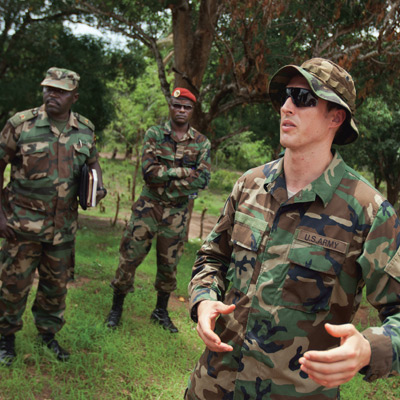
Executive Summary
The U.S. military advisors deployed against Joseph Kony’s Lord’s Resistance Army in central and east Africa are starting to make progress in tracking the group, but serious challenges remain to make the mission a success. The elusive rebel group, the Lord’s Resistance Army, or LRA, continues to attack and displace civilians in the Democratic Republic of Congo and the Central African Republic, and LRA units have been allegedly sighted in South Sudan and Sudan. In fact the LRA has had and continues to have an uninterrupted route from their hideouts in southeastern Central African Republic all the way toward Darfur. The current strength of the LRA is estimated to be 250 to 300 fighters. Despite its small size, the group continues to terrorize large areas of central Africa. This report, which is based on a field visit to the Central African Republic in March-April 2012,1 analyzes progress and challenges in the military and non-military initiatives to end the LRA.
Despite the recent arrest of the LRA’s fourth-highest ranking commander, Major General Caesar Acellam, current efforts aimed at apprehending the LRA leadership and disbanding the group are greatly under-resourced and slowly getting underway. For example, it took four months for the U.S. military advisors to be fully deployed to their forward operating locations and set up bases there. Meanwhile, field research shows that the LRA is not in “survival mode,” as many analysts have suggested, but rather the contrary. The LRA continues to extend its area of operation. Recent attacks and abductions
show that the LRA remains a highly capable rebel force. The first quarter of 2012 witnessed a sharp increase in LRA-related incidents in the affected areas, with the LRA being responsible for at least 53 attacks, nine deaths, 90 abductions, and the continued displacement of more than 445,000 civilians across the region.
In order for the advisors to succeed in apprehending the LRA’s senior leadership and encouraging commanders and fighters to leave the group, several major obstacles must be addressed. More Special Forces are needed to penetrate the vast jungles and to pursue more effectively Kony and his top deputies. Non-Special Forces are also in short supply; further deployment is urgently needed to protect civilians from LRA attacks and abductions. Enhanced intelligence gathering and transportation capabilities are critical if the whereabouts of LRA groups are to be located in real time and if the regional forces are to respond rapidly. The militaries involved must be able to access all areas where the LRA operates. Lastly, LRA-specific defection initiatives and DDRRR (Demobilization, Disarmament, Repatriation, Resettlement, Reintegration) programs must also be increased in scale and intensity across the region.
President Barack Obama’s April 23, 2012 announcement to extend the deployment of the military advisors was a welcome restatement of his administration’s commitment to ending the LRA.3 The advisors are strengthening intelligence gathering about the LRA; facilitating forums where intelligence is shared; and improving the performance of the Ugandan military, the most engaged military in the loose regional coalition fighting the LRA. But unless key challenges are addressed urgently, the mission is likely to fail.
Finding the LRA is not an easy task. Even sophisticated aerial surveillance equipment is challenged by
the thickness of the forest, high temperature, and the sheer size of the area where the LRA is hiding.
Recent reports suggest that Joseph Kony has left the Central African Republic, or CAR, and has crossed into Darfur, possibly receiving support from the Sudanese government. It is unclear where Kony’s group is currently located. Kony’s ability to move from CAR to Darfur unimpeded is highly troubling and clearly shows that more forces are needed to cover all of the areas where the LRA is and could become active.
The Ugandan army, the most capable force pursuing the LRA, must have full access to all LRA-affected areas in CAR and the northwest corner of South Sudan. Negotiations must result in Ugandan forces gaining permission to re-enter the Democratic Republic of the Congo, where they have been unable to operate for over seven months on the orders of the Congolese government.
The quest to end the LRA can only succeed through a multifaceted strategy where the affected countries and international partners work closely together on military and nonmilitary initiatives. The time for debate is over; policymakers across the region and internationally must take the necessary steps to end the continued suffering of civilians who pay the ultimate price for the horrible atrocities committed by the LRA.
Photos: Obo, Central African Republic (Kasper Agger/Enough Project)

